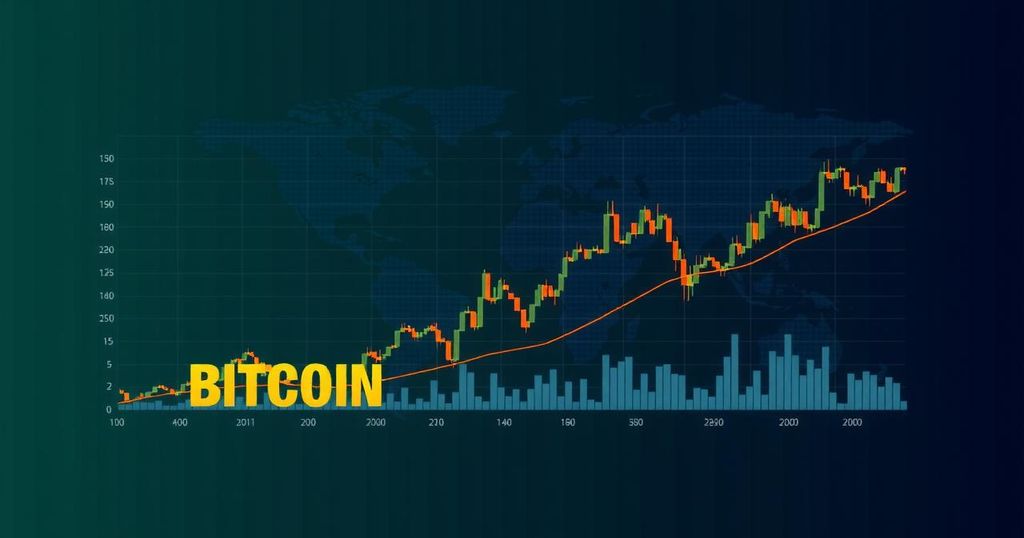The Fed’s Rate Cut and Its Implications for Bitcoin’s Future
Summary
Anticipation builds around potential Federal Reserve rate cuts, which may establish a new Bitcoin baseline. Despite short-term volatility in crypto markets, longer-term trends favor a bullish outlook, driven by institutional investments and the advent of ETFs. The significant increase in Bitcoin’s value diverges from expected monetary conditions, indicating a fundamental shift in the market.
The recent discussions around potential Federal Reserve (Fed) rate cuts are generating significant anticipation within both the cryptocurrency and broader investment markets. A prospective rate cut of 50 basis points, currently assessed at a 60% likelihood, could establish a new baseline for Bitcoin and, consequently, set the tone for the entire crypto ecosystem. Currently, volatility pervades the crypto sector, notably affecting Bitcoin. Market participants may exhibit immediate reactions to the Fed’s announcement of a rate cut, likely resulting in market corrections as short-term dynamics play out. Investor sentiment largely stems from concerns surrounding the trajectory of the U.S. and global economies. Nevertheless, it is crucial to maintain a long-term perspective amidst this volatility. Short-term inflow and outflow trends should be regarded with caution, as the substantial narrative concerning easing monetary conditions poses the potential for a renewed bullish cycle across Bitcoin, Ethereum, and alternative cryptocurrencies. Historically, Bitcoin has shown correlations with major stock indices, like the Nasdaq, reflecting movements aligned with monetary policies over time, particularly as investors seek yields in a low-rate environment. However, Bitcoin’s recent all-time high (ATH) was a notable anomaly, occurring contrary to the expected cyclicality typically observed in high-risk assets, marking it as a unique event in the cryptocurrency’s history. Such an unprecedented ATH could indicate that, following the absorption of short-term market fluctuations, Bitcoin might have established a new baseline. This is especially significant in light of expected rate cuts that could revitalize the market. From an investment perspective, cryptocurrencies demonstrate a forward-pricing behavior, where capital is allocated towards riskier assets based on anticipated future performance, rather than immediate economic conditions. The exceptional rise of Bitcoin this year to a new ATH is particularly noteworthy as it diverges from expected monetary policy outcomes. The introduction of Exchange-Traded Funds (ETFs) has played a pivotal role in this transformation, facilitating a substantial reallocation of institutional and retail capital towards Bitcoin, independent of prevailing monetary conditions. Observably, Bitcoin is not the sole cryptocurrency experiencing a secular uptrend this year. Tokenized assets are thriving, reflecting a growing acknowledgment from traditional finance (TradFi) investors regarding the crypto market’s potential. As Bitcoin and Ethereum serve as foundational assets for this burgeoning market, the prospects for auxiliary projects appear promising amidst a comprehensive financial reallocation from traditional manpower into on-chain ecosystems. The present environment contrasts sharply with the ‘crypto winter’ of 2022, characterized by increasing interest from retail investors, alongside heightened participation from high-net-worth individuals and institutional investors. The advent of ETFs has equipped these capital pools with the necessary access to opportunities in Bitcoin, precious metals like gold, and equities at a timely juncture in economic policymaking. While uncertainties linger regarding the Fed’s decisions, the prospect of easing monetary conditions, when they eventually materialize, is likely to accelerate the expansion of the crypto sector. This sets a positive trajectory for the upcoming years as the market continues to strengthen.
The article discusses the impact of potential Federal Reserve interest rate cuts on the cryptocurrency market, particularly Bitcoin. It highlights the relationship between monetary policy and Bitcoin’s price movements, noting how historical correlations exist with major stock indices. The piece emphasizes the importance of long-term trends over short-term volatility and points to the emergence of ETFs as a game-changer in driving investment towards Bitcoin and other cryptocurrencies. The narrative also touches on the shift of capital from traditional finance to the crypto space, indicating a broader acceptance and interest in digital assets amid changing economic conditions.
In conclusion, the anticipation surrounding the Fed’s decision regarding interest rate cuts holds significant implications for the cryptocurrency market, particularly Bitcoin. As the market navigates through current volatility, it is crucial to focus on long-term trends and the transformative effects of ETFs that are fostering greater institutional participation. The evolving landscape suggests that a new baseline for Bitcoin may be forming, setting a promising course for the crypto sector’s future as it continues to garner interest from traditional finance investors.
Original Source: www.coindesk.com







Post Comment